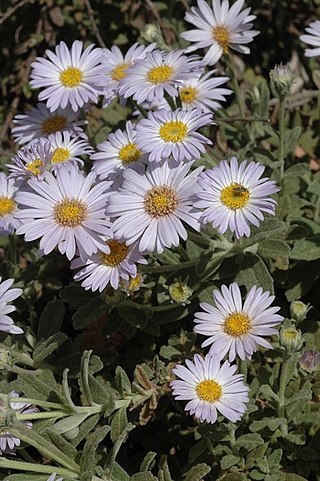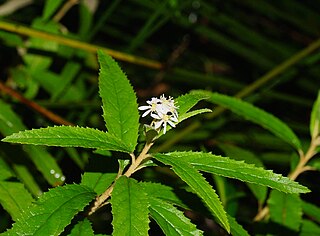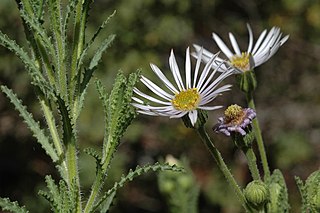
Olearia argophylla, commonly known as musk daisy-bush, native musk or silver shrub, is a species of flowering plant in the family Asteraceae and is endemic to south-eastern Australia. It is a shrub or tree with silvery branchlets, egg-shaped to elliptic leaves, and white and yellow, daisy-like inflorescences.

Olearia axillaris, commonly known as coastal daisy-bush, coast daisy-bush or coastal daisybush is a species of flowering plant in the family Asteraceae and is endemic to coastal areas of Australia. It is an erect, bushy shrub with densely cottony-hairy branchlets, aromatic, linear to narrowly elliptic or narrowly lance-shaped to egg-shaped leaves with the narrower end towards the base and small white and yellow, daisy-like inflorescences.

Olearia ramulosa, commonly known as twiggy daisy-bush, is a species of flowering plant in the family Asteraceae and is endemic to south-eastern Australia. It is a shrub with narrowly elliptic, linear or narrowly egg-shaped leaves, and pale blue, mauve or white and yellow, daisy-like inflorescences.

Olearia myrsinoides, commonly known as silky daisy-bush or blush daisy bush, is a species of flowering plant in the family Asteraceae and is endemic to south-eastern Australia. It is a spreading shrub with hairy branchlets, egg-shaped to elliptic leaves with toothed edges, and white and yellow or mauve, daisy-like inflorescences.

Olearia oppositifolia is a species of flowering plant in the family Asteraceae and is endemic to eastern Australia. It is a shrub with egg-shaped to elliptic leaves arranged in opposite pairs, and white and yellow daisy flowers.
Olearia curticoma is a species of flowering plant in the family Asteraceae and is endemic to Victoria. It is an erect shrub with glabrous, sticky branchlets, linear leaves and white and yellow, daisy-like inflorescences.
Olearia eremaea is a species of flowering plant in the family Asteraceae and is endemic to inland areas of Western Australia. It is a shrub with scattered, more or less elliptic leaves, and white and yellow, daisy-like inflorescences.
Olearia fluvialis is a species of flowering plant in the family Asteraceae and is endemic to inland areas of northern Western Australia. It is a shrub with scattered, narrowly egg-shaped leaves, and white or mauve and yellow, daisy-like inflorescences.

Olearia frostii, commonly known as Bogong daisy-bush, is a species of flowering plant in the family Asteraceae and is endemic to Victoria in Australia. It is a low, often straggling shrub with egg-shaped leaves with the narrower end towards the base, and mauve to pink and yellow, daisy-like inflorescences.

Olearia heterocarpa, commonly known as Nightcap daisy bush, is a species of flowering plant in the family Asteraceae and is endemic to eastern Australia. It is a shrub with narrowly elliptic or lance-shaped leaves with toothed edges, and white and yellow, daisy-like inflorescences.

Olearia humilis is a species of flowering plant in the family Asteraceae and is endemic to the south-west of Western Australia. It is an erect, spindly shrub with narrowly egg-shaped or linear leaves, and purple and yellow, daisy-like inflorescences.
Olearia incana is a species of flowering plant in the family Asteraceae and is endemic to southern Australia. It is a shrub with narrowly elliptic or wedge-shaped leaves and white and pale yellow, daisy-like inflorescences.
Olearia incondita is a species of flowering plant in the family Asteraceae and is endemic to the south-west of Western Australia. It is a straggly shrub with narrowly elliptic leaves and white or pink and yellow, daisy-like inflorescences.

Olearia laciniifolia is a species of flowering plant in the family Asteraceae and is endemic to inland areas of the south-west of Western Australia. It is an erect shrub with scattered oblong leaves with small lobes on the edges, and lilac, white and yellow, daisy-like inflorescences.
Olearia lasiophylla is a species of flowering plant in the family Asteraceae and is endemic to south-eastern New South Wales. It is a shrub with hairy, elliptic leaves and white or mauve, and yellow daisy-like inflorescences.
Olearia macdonnellensis is a species of flowering plant in the family Asteraceae and is endemic to a restricted part of the Northern Territory of Australia. It is an erect, bushy shrub shrub with broadly elliptic to broadly egg-shaped leaves and yellow, or white and yellow, daisy-like inflorescences.
Olearia plucheacea is a species of flowering plant in the family Asteraceae and is endemic to inland Western Australia. It is an erect, open shrub with scattered hairy, thread-like to linear leaves, and white and yellow daisy-like inflorescences.

Olearia stellulata is a species of flowering plant in the family Asteraceae and is endemic to south-eastern Australia. It is a shrub with lance-shaped or narrowly elliptic leaves, and white and yellow or mauve, daisy-like inflorescences.

Olearia subspicata, commonly known as spiked daisy bush or shrubby daisy-bush, is a species of flowering plant in the family Asteraceae and is endemic to continental Australia. It is an erect shrub with more or less linear leaves and white and yellow, daisy-like inflorescences.

Olearia teretifolia is a species of flowering plant in the family Asteraceae and is endemic to south-eastern Australia. It is a bushy shrub with lance-shaped, egg-shaped or elliptic leaves arranged in opposite pairs, and white and yellow, daisy-like inflorescences.













